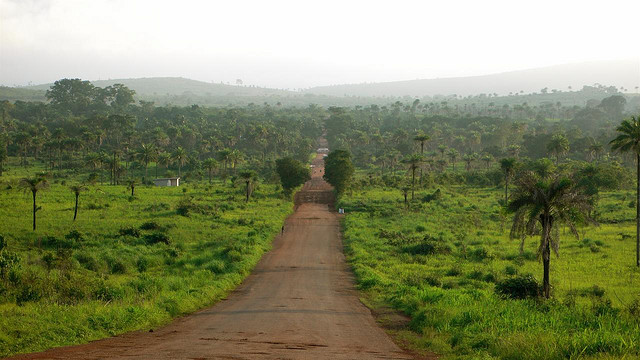
The heavy heat of the tropical afternoon sun was almost as oppressive as the news of ‘blanket amnesty’ being granted to all the rebel factions who had fought in the vicious 12-year civil war in Sierra Leone, West Africa. I was with the Sierra Leone refugee community in 2001, “sitting in the fire” of the shock of this BBC announcement of total impunity as it crackled and sputtered out of portable, transistor radios clutched to the ears of the refugees. In silence, I searched for understanding in the haunted and tearing eyes of my refugee friends and colleagues – people who had seen their families killed in front of their eyes, who had their villages pillaged and burned, many who had their arms and legs amputated in horrific campaigns of terror perpetrated by the rebels. These were a broken, heavy-hearted, and traumatized people. They were tired of war.
As these refugee friends begin to respond the news some of their eyes sparked with flashes of rage and vengeance – “If these rebels enter my village, I will kill them!” While many others, their eyes glazed with a hollow stare, shrugged their shoulders in wearied resignation saying, “What can we do, this is the only way to have peace – we must figure out how to live together somehow.” The injustice of blanket amnesty brought with it another ‘blanket’ of heavy apathy about the future. The polarizing and paralyzing emotions of revenge on the one hand, and apathy on the other were thick in the air.
Unable to bridge this emotive chasm, I left the refugee gathering with a heavy heart, wrestling with my own anger, despair and despondency. In that dark night I cried out to God, “There has got to be a better way – this is not justice – where is real justice in this all?” The very foundations of a nation like Sierra Leone struggling to rebuild itself will crumble if its future generations are consigned to act off of a narrative script of ‘justified revenge’ or ‘resigned apathy’. I needed a glimpse of another way – another path between violence and hopelessness.
The Sierra Leonean refugees were crying out for justice. The question is: How is justice truly satisfied? What does justice require? What does justice feel like? Many say justice meets violence with violence (retributive). Others have numbed their psyches feeling powerless that there is nothing they can do (justice as fate – a Divine command or a Natural Law). Still others understand justice as social fairness, rights-based egalitarianism and the search for the maximization of the “common good” (a kind of Utilitarian or Distributive Justice). Elements of all these conceptions of justice permeate the guiding principles of what is now termed “Transitional Justice” – a burgeoning field of systematic justice that aims to reconstruct the human and material capital of societies that have experienced mass atrocities.
In its best form, Transitional Justice should be “restorative” in its nature. The field of Restorative Justice as an academic discipline and as a global practice movement is relatively young (early 1970s, see link below) with its contemporary origins rooted in experiments in alternative criminal diversion in Canada. However, in many ways it is simply a revitalization of ancient practices of justice not too far distant in each of our own cultural traditions, but eclipsed by our current Western justice system. Restorative Justice is concerned with right relationships and the reconstruction of community and collective harmony after an outbreak of violence. It is a justice that demands accountability (recognizing the harm and taking responsibility), making clear that no act that destroys the dignity of humanity goes unnoticed. However, along with this accountability it always creates an avenue for restoration (equalizing power and addressing future intentions through restitution, reparations and reconciliation). Instead of a justice system that is obsessed with apportioning blame and shame, and administering pain and isolation, restorative justice seeks to heal the harms of victims, rehabilitate offenders and reintegrate both of them into community networks of support as a safeguard of justice. It is simple, but never easy.
In these troubled times we can easily find ourselves on either end of the polemic of revenge or apathy in response to our political and legal justice needs. However, there is a third way – an innovative alternative process of Restorative Transitional Justice that utilizes the social, spiritual, and cultural resources of communities to transform individuals and societies who have been affected by severe violence. This is truly our only viable option for the future. Generational justice requires that we leverage a restorative approach that is able to respond to a death-dealing world with a life-giving reality. This is our hope for justice amidst the rubble.
Related post: Yes and No to restorative justice as “a Mennonite thing” – Restorative Theology
 [Carl Stauffer, PhD (MA ’02), is Assistant Professor of Development and Justice Studies at Eastern Mennonite University’s Center for Justice and Peacebuilding. Originally from the Shenandoah Valley of Virginia (US), Carl worked for 16 years with Mennonite Central Committee at peacebuilding efforts across the African continent, particularly in southern Africa.]
[Carl Stauffer, PhD (MA ’02), is Assistant Professor of Development and Justice Studies at Eastern Mennonite University’s Center for Justice and Peacebuilding. Originally from the Shenandoah Valley of Virginia (US), Carl worked for 16 years with Mennonite Central Committee at peacebuilding efforts across the African continent, particularly in southern Africa.]
